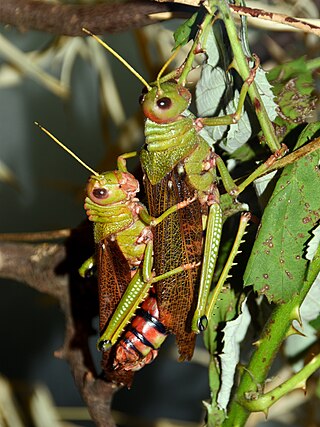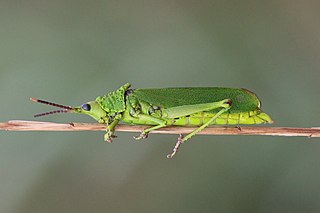
The grasshopper subfamily Acridinae, sometimes called silent slant-faced grasshoppers, belong of the large family Acrididae in the Orthoptera: Caelifera.

Phymateus viridipes, also known as the green milkweed locust or African bush grasshopper, is an African locust in the family Pyrgomorphidae.

Pyrgomorphidae is a family of grasshoppers in the order Orthoptera; it is the only family in the superfamily Pyrgomorphoidea. Pyrgomorphidae is found worldwide in tropical and warm temperate regions, but the vast majority of the family's approximately 500 species are from Africa, Asia and Australia. Their name is probably derived from pyrgos meaning "tower": a reference to the form (morph) of the head in the type genus Pyrgomorpha and other genera.

Dictyophorus spumans, the koppie foam grasshopper or rooibaadjie, is a species of grasshopper in the family Pyrgomorphidae indigenous to southern Africa. The name "foaming grasshopper" derives from the insect's ability to produce a toxic foam from its thoracic glands. Its genus Dictyophorus is closely related to Phymateus.

Atractomorpha is a genus in the Pyrgomorphidae, a family of grasshoppers, found in Africa, Asia, and Australia.

Petasida ephippigera, the Leichhardt's grasshopper, is a relatively large, brightly coloured pyrgomorph species of grasshopper in the monotypic genus Petasida, native to the Top End region of tropical northern Australia.

Chorotypidae is a family of tropical Asian grasshoppers, formerly included within the family Eumastacidae. These grasshoppers have a head that rises above the level of the thorax and short antennae. Some species have reduced wings, others have wings that widen towards the tips and still others have a flattened leaf-like shape. They lack abdominal tympani.

Tropidacris is a Neotropical genus of grasshopper in the family Romaleidae. They are among the largest grasshoppers in the world by length and wingspan, reaching up to 14.5 cm (5.7 in) and 24 cm (9.4 in) respectively. They are variably colored in green, brown, black, reddish or yellowish, and have wings that usually are conspicuously blue or red in flight. The gregarious and flightless nymphs have bright aposematic colors and are presumed to be toxic; a researcher who tasted one noted that it was very bitter, similar to a monarch butterfly.

Atractomorpha crenulata, commonly known as the tobacco grasshopper, is a species of grasshopper in the subfamily Pyrgomorphinae, found in Asia.

Zonocerus is a genus of grasshoppers (Caelifera) in the family Pyrgomorphidae and the tribe Phymateini. The two species are found in Africa, with Z. elegans found in central, eastern and southern regions, including Madagascar, and Z. variegatus found in western regions. Both species are significant agricultural pests, especially for African smallholder farmers. Both adults and nymphs have relatively bright, aposematic colours, and adults typically are about 3–5 cm (1.2–2.0 in) long.

Poekilocerus is a genus of grasshoppers in the family Pyrgomorphidae and the monotypic tribe Poekilocerini. Species are found in the northern half of Africa, and in Southwest and South Asia, often in arid or semi-arid areas.

Pyrgomorpha is the type genus of grasshoppers in the family Pyrgomorphidae and the tribe Pyrgomorphini. Species are found in Southern Europe, Africa and the middle East, through to India and Mongolia.

The Pyrgomorphinae are a subfamily of grasshoppers in the family Pyrgomorphidae. Species are found in, especially the warmer parts of: Central and South America, southern Europe, Africa, Asia, Australia and Pacific Islands. The type genus is Pyrgomorpha and names dates from "Pyrgomorphiden" by Brunner von Wattenwyl, 1874. The first use of Pyrgomorphinae was by Krauss in 1890.

The Orthacridinae are a sub-family of grasshoppers in the family Pyrgomorphidae. Species are found in: Central America, Africa, Asia, Australia and certain Pacific Islands. The type genus is Orthacris and the taxon proposed by Bolívar in 1905.

Dictyophorus griseus is a species of grasshopper in the family Pyrgomorphidae, the gaudy grasshoppers, native to tropical Africa. Adults are typically about 5–6.5 cm (2.0–2.6 in) long.

Phymateus karschi is a locust in the family Pyrgomorphidae.

Taeniopoda is a genus of horse lubbers, fairly large grasshoppers in the family Romaleidae that are native to southwestern United States, Mexico and Central America. There are about 12 described species in Taeniopoda. Taeniopoda is very closely related to Romalea, leading some recent authorities to consider the former a junior synonym the latter.

Dictyophorus is the type genus of grasshoppers in the tribe Dictyophorini, of the family Pyrgomorphidae; it is native to sub-Saharan Africa. The genus was named by Carl Peter Thunberg in 1815. They are relatively large, typically about 4–7 cm (1.6–2.8 in) long, and often have bright colurs warning of their toxicity.

Maura is a genus of grasshoppers in the tribe Dictyophorini and the family Pyrgomorphidae; it is native to sub-Saharan Africa.
Euryphymus is the type genus of grasshoppers in the subfamily Euryphyminae, erected by Carl Stål in 1873 as a subgenus of "Calliptenus" (Euryphymus). Species have been recorded from southern Africa and Madagascar.























